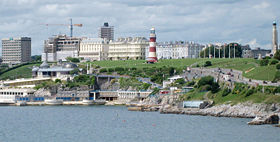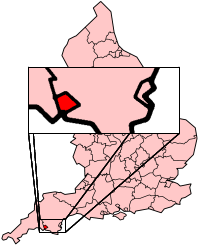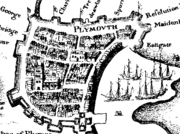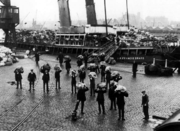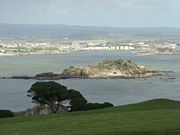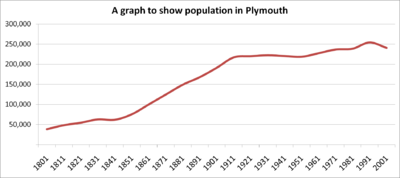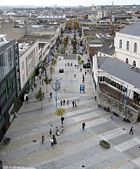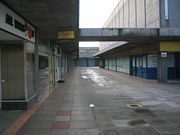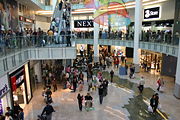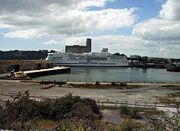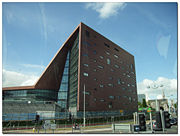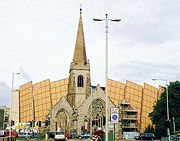Plymouth
2008/9 Schools Wikipedia Selection. Related subjects: British Cities; Great Britain
| Plymouth | |||
| — Unitary Authority — | |||
| View of Plymouth Hoe Waterfront | |||
|
|||
| Nickname(s): Spirit of Discovery | |||
| Motto: Turris fortissima est nomen Jehova "The name of Jehova is the strongest tower" |
|||
| Plymouth shown within Devon and England | |||
| Coordinates: | |||
|---|---|---|---|
| Sovereign state | United Kingdom | ||
| Constituent country | England | ||
| Region | South West England | ||
| City status | 1928 | ||
| Unitary Authority | 1998 | ||
| Government | |||
| - Type | City Council | ||
| - Lord Mayor | Brian Vincent | ||
| - HQ | Civic centre building | ||
| - Wards | 20 | ||
| - UK Parliament | Plymouth Sutton South West Devon Plymouth Devonport |
||
| - European Parliament | South West England | ||
| Area | |||
| - Total | 30.6 sq mi (79.29 km²) | ||
| Highest elevation | 509 ft (155 m) | ||
| Lowest elevation | 0 ft (0 m) | ||
| Population (2005 est.) | |||
| - Total | 246,100 | ||
| - Density | 7,989/sq mi (3,085/km²) | ||
| Time zone | GMT ( UTC0) | ||
| - Summer ( DST) | BST ( UTC+1) | ||
| Postcode district | PL1-9 | ||
| Website: www.plymouth.gov.uk | |||
Plymouth ( ˈplɪməθ ) is a city and unitary authority area in Devon, England, about 190 miles (310 km) south west of London. It is built between the mouths of the rivers Plym and Tamar, where they join Plymouth Sound. Since 1967 the unitary authority of Plymouth has included the suburbs of Plympton and Plymstock, which are on the other side of the River Plym.
Plymouth’s history goes back to the Bronze Age, when its first settlement grew at Mount Batten. This settlement continued to grow as a trading post for the Roman Empire, until the more prosperous village of Sutton, the current Plymouth, surpassed it. In 1620 the Pilgrim Fathers left Plymouth for the New World, establishing the first colony of the United States of America. During the English Civil War the town was held by the Parliamentarians and was besieged between 1642 and 1646.
Throughout the Industrial Revolution Plymouth grew as a major shipping port, handling imports and passengers from the Americas and the construction of ships, ranging from small fishing boats to battleships for the Royal Navy. This later led to its targeting and partial destruction during World War Two, an act known as the Plymouth Blitz. After the war the city centre was completely rebuilt.
Today the city is home to nearly 250,000 people, making it the 15th most populous city in England. It has its own city council and is represented nationally by three MPs. Plymouth’s economy is still strongly influenced by shipbuilding, but has since the 1990s become a more service-based economy with the 11th largest university in the United Kingdom. Its naval base, HMNB Devonport is the largest operational naval base in Western Europe. Plymouth has ferry links to France and Spain and an airport with national services.
History
Early history
Upper Palaeolithic deposits, including bones of Homo sapiens, have been found in local caves, and artefacts dating from the Bronze Age to the Middle Iron Age have been found at Mount Batten showing that it was one of the main trading ports of the country at that time. Meanwhile the port of Plympton, further up the River Plym than the current Plymouth, was also trading by sea. But the river soon silted up and the mariners and merchants settled at the current day Barbican near the river mouth. At the time this village was called Sutton, meaning south town in Saxon. The name Plymouth, a back-formation from Plympton ("Plum-tree town"), was first mentioned in a Pipe Roll of 1211.
During the Hundred Years' War a French attack (1340) burned a manor house and took some prisoners, but failed to get into the town. In 1403 the town was burned by Breton raiders. A series of fortifications were built in the Tudor and Elizabethan era which include the four round towers featured on the city coat of arms; the remains of two of these can still be found at Mount Batten and at Sutton Pool below the Royal Citadel.
Renaissance Age
During the 16th century, Plymouth was the home port for successful maritime traders, among them Sir John Hawkins, who led England's first foray into the slave trade, as well as Sir Francis Drake, who insisted on completing his game of bowls on the Hoe before engaging the Spanish Armada in 1588. During their time locally produced wool was the major export commodity. In 1620 the Pilgrim Fathers set sail for the New World from Plymouth, establishing the first colony of the United States of America.
During the English Civil War Plymouth sided with the Parliamentarians and was besieged for almost four years by the Royalists. Construction of the Royal Citadel began in 1665, after the Restoration; it was armed with cannon facing both out to sea and into the town, rumoured to be a reminder to residents not to oppose the Crown.
Rise of naval power
Throughout the 17th century Plymouth had gradually lost its pre-eminence as a trading port. By the mid-1600s commodities manafactured elsewhere in England cost too much to transport to Plymouth and the city had no means of processing sugar or tobacco imports, although it played a relatively small part in the Slave trade during the early 1700s. In 1690 the first Royal Dockyard opened on the banks of the Tamar and further Docks were built in 1727, 1762 and 1793. In the 18th century new houses were built near the dock, called Plymouth Dock at the time, and a new town grew up. In 1712 there were 318 men employed and by 1733 it had grown to having a population of 3,000 people.
Prior to the latter half of the 18th century Grain, timber and then coal were the greatest imports. In 1815, Napoleon Bonaparte was brought to Plymouth for two weeks before his exile to St Helena. During this time the real source of wealth and the major employer in the region became the dockyard. The Three Towns enjoyed some prosperity during the late eighteenth and early nineteenth century and were enriched by a series of neo-classical urban developments designed by London architect John Foulston. Foulston was important for the town and was responsible for several grand public buildings, many now destroyed, including the Athenaeum, the Theatre Royal and Royal Hotel, and much of Union Street. Some of the greatest imports to Plymouth from the Americas and Europe during the latter half of the 19th cenury included maize, wheat, barley, sugar cane, guano, nitrate of soda and phosphate. Aside from the dockyard, other industries such as the gasworks, the railways and tramways and a number of small chemical works had begun to develop in the 19th century continuing into the 20th century.
Twentieth Century
The city was heavily bombed by the Luftwaffe during the Second World War in a series of 59 raids known as the Plymouth Blitz. Although the dockyards were the principal targets, much of the city centre and over 3,700 houses were completely destroyed and more than 1,000 civilians lost their lives. The redevelopment of the city was planned by Sir Patrick Abercrombie and by 1964 over 20,000 new homes had been built, but despite this in 1971 over ten percent of the houses in Plymouth were still occupied by more than one family. Devonport Dockyard was kept busy for many years refitting aircraft carriers such as the Ark Royal. By the time this work ended in the late 1970s the nuclear submarine base was operational. The army had substantially left the city by 1971, with barracks pulled down in the 1960s, however the city has become home to more Royal Marines.
Governance
Local government history
In 1914 the county boroughs of Plymouth and Devonport, and the urban district of East Stonehouse merged to form a single county borough of Plymouth. Collectively they were referred to as " The Three Towns". A provisional order was made on 2 May 1914, to come into effect in November. Plymouth was granted city status on 18 October 1928. The city's first Lord Mayor was appointed in 1935 and its boundaries further expanded in 1967 to include the town of Plympton and the parish of Plymstock.
The 1971 Local Government White Paper proposed abolishing county boroughs, which would have left Plymouth, a town of 250,000 people, being administered from a council based at the smaller Exeter, on the other side of the county. This led to Plymouth lobbying for the creation of a Tamarside county, to include Plymouth, Torpoint, Saltash, and the rural hinterland. The campaign was not successful, and Plymouth ceased to be a county borough on 1 April 1974 with responsibility for education, social services, highways and libraries transferred to Devon County Council. All powers returned when the city become a unitary authority on 1 April 1998 under recommendations of the Banham Commission.
City Council
The City of Plymouth is divided into 20 wards, 17 of which elect three councillors and the other three electing two councillors, making up a total council of 57. Councillors are also known as Members of the Council and usually stand for election as members of national political parties. Full local elections are held every four years with elections for one third of Council seats being held each intervening year; the total electorate for Plymouth was 184,956 in December 2003. The local election of May 2006 resulted in a political composition of 26 Labour and 31 Conservative councillors.
Council sessions have a Chairman and Vice-Chairman, who are entitled Lord Mayor and Deputy Lord Mayor respectively. The Lord Mayor also has a ceremonial role and historical regalia. The Leader of the Council has day to day power which is exercised as Chairman of the Cabinet and there is a leader of each political group. The Lord Mayor is elected annually in May; as at May 2008 Brian Vincent holds the position for the Labour Party. The dignity of Lord Mayor was granted in 1935, previously the office was simply Mayor – there have been over 540 holders of the office since its establishment in 1439.
The Lord Mayor's official residence is 3 Elliot Terrace, located on the Hoe. Once a home of Waldorf and Nancy Astor, it was given by Lady Astor to the City of Plymouth as an official residence for future Lord Mayors and is also used today for civic hospitality, as lodgings for visiting dignitaries and High Court judges. The Civic Centre municipal office building in Armada Way became a listed building in June 2007 because of its quality and period features, but has become the centre of a controversy as the council disagrees. In September 2007 the city council announced its application to demolish the building.
In Parliament, Plymouth is represented by the three constituencies of Plymouth Devonport, Plymouth Sutton and Southwest Devon. As of the 2005 General Election the two former constituencies are held by Labour MPs Alison Seabeck and Linda Gilroy respectively with the latter held by Conservative MP Gary Streeter. The city is part of South West England and Gibraltar in the European parliament.
Plymouth City Council is formally twinned with:
 Brest, Brittany, France (twinned 1963)
Brest, Brittany, France (twinned 1963) Gdynia, Pomeranian Province, Poland (twinned 1976)
Gdynia, Pomeranian Province, Poland (twinned 1976) Novorossiysk, Krasnodar Krai, Russia (twinned 1990)
Novorossiysk, Krasnodar Krai, Russia (twinned 1990) San Sebastián, Basque Country, Spain (twinned 1990)
San Sebastián, Basque Country, Spain (twinned 1990) Plymouth, Massachusetts, United States (twinned 2001)
Plymouth, Massachusetts, United States (twinned 2001)
The city also maintains a link with:
 Sekondi-Takoradi, Western Region, Ghana
Sekondi-Takoradi, Western Region, Ghana
and has educational and economic links with:
 Jiaxing, Zhejiang province, China (since 2006)
Jiaxing, Zhejiang province, China (since 2006)
Geography
Plymouth lies between the River Plym to the east and the River Tamar to the west; both rivers flow into the natural harbour of Plymouth Sound. The River Tamar forms the county boundary between Devon and Cornwall and its estuary forms the Hamoaze on which is sited Devonport Dockyard. Plymouth Sound is protected from the sea by the Plymouth Breakwater, in use since 1814. In the Sound is Drake's Island which is seen from Plymouth Hoe, a flat public area on top of limestone cliffs. The Unitary Authority of Plymouth is 30.8 square miles (79.78 km²), but the city of Plymouth, as cited from Plymouth City Council, is 30.61 square miles (79.29 km²). The topography rises from sea level to a height, at Roborough, of about 509 feet (155 m) above Ordnance Datum (AOD). The River Plym which flows off Dartmoor to the north east forms a smaller estuary to the east of the city; the mouth of this estuary is called Cattewater. On its south bank lies the outcrop of Mount Batten, the earliest-known settlement in the area; and on its north bank was the manor of Sutton which grew to form the present day city.
The geology of Plymouth has a mixture of Limestone, Devonians slate, Granite and Middle Devonian Limestone. The bulk of the city is built upon Upper Devonian slates and shales, which have been greatly folded and faulted and the rocks become progressively younger from South to North. The headlands at the entrance to Plymouth Sound are formed of Lower Devonian slates, which can withstand the power of the sea. A band of Middle Devonian limestone, formed from the coral reefs that grew in warm shallow waters, runs west to east from Cremyll to Plymstock including the Hoe. Local limestone may be seen in numerous buildings, walls and pavements throughout Plymouth. There is evidence within the city of the volcanic activity of the Devonian period at such places as Ford, Hartley and Plymstock. To the north and north east of the city the granite mass of Dartmoor has had a profound impact on climate and economic activity. Granite has historically been exported around the world via Plymouth. Rocks around the edge of the Dartmoor granite mass were not only changed by the heat of the intrusion but were also heavily mineralised by fluids driven by the heat. This has given rise to ores containing tin, copper, tungsten, lead and other minerals in the Tamar Valley. The middle Devonian limestone belt in the south edge of Plymouth and in Plymstock has been quarried for many years. There is clear evidence of former activity at West Hoe, Cattedown and Radford. Currently quarrying takes place at two sites in Plymstock where the limestone has been worked over the last hundred years.
In 1945 Sir Patrick Abercrombie's 1943 Plan for Plymouth was published to rebuild the city. It called for the destruction of the few remaining pre-War buildings in the city centre and their replacement with wide, modern boulevards aligned east-west linked by a grand north-south avenue ( Armada Way) linking the railway station with Plymouth Hoe. The Plan had to deal not only with the effects of the War, but also the pre-war defects of the city: much of the housing and many narrow streets were overcrowded. The main concern was for housing, and many prefabs were built by 1946, followed by over a thousand permanent council houses built each year from 1951–1957. By 1964 over 20,000 new homes had been built, more than 13,500 of them permanent council homes and 853 built by the Admiralty. To compensate for the large scale of housing Plymouth has a number of public parks, the largest of which is Central Park. Other sizeable green spaces include Victoria Park, Freedom Fields Park, Alexandra Park, and significantly, the Hoe.
| Climate chart for Plymouth | |||||||||||
|---|---|---|---|---|---|---|---|---|---|---|---|
| J | F | M | A | M | J | J | A | S | O | N | D |
|
114
9
3
|
92
8
3
|
87
10
4
|
59
12
6
|
61
15
8
|
57
18
11
|
55
20
13
|
69
19
13
|
76
18
11
|
95
15
9
|
101
11
6
|
116
10
4
|
| temperatures in °C precipitation totals in mm |
|||||||||||
|
Imperial conversion
|
|||||||||||
Climate
Along with the rest of South West England, Plymouth has a temperate climate which is generally wetter and milder than the rest of England. The annual mean temperature is approximately 11 °C (52 °F) and shows a seasonal and a diurnal variation, but due to the modifying effect of the sea the range is less than in most other parts of the UK. February is the coldest month with mean minimum temperatures between 3 °C (37 °F) and 4 °C (39 °F). July and August are the warmest months with mean daily maxima over 19 °C (66 °F).
South West England has a favoured location with respect to the Azores high pressure when it extends its influence north-eastwards towards the UK, particularly in summer. Coastal areas have average annual sunshine totals over 1,600 hours.
Rainfall tends to be associated with Atlantic depressions or with convection. The Atlantic depressions are more vigorous in autumn and winter and most of the rain which falls in those seasons in the south-west is from this source. Average annual rainfall is around 980 millimetres (39 in). The number of days with snow falling is typically fewer than ten per winter. November to March have the highest mean wind speeds, with June to August having the lightest winds. The predominant wind direction is from the south-west.
Demography
In 2005, Plymouth's population was estimated at 246,100 by Plymouth City Council, 5,380 more people than that of the last census from 2001, which indicated that Plymouth had a population of 240,720. The average household size was 2.3 persons. To the right is a graph showing the population change of the city since 1801. The population rose rapidly during the second half of the 19th century. The decline of over 1.6% from 1931 to 1951, including the period of World War II, is notable. Plymouth's GVA (a measure of its economy) was 3.501 billion GBP in 2004 making up aprroximately one quarter of Devon's economy. Its GVA per capita was 14,327 and compared to the national average ,of 17,115, it was 2,788 lower.
At the time of the 2001 UK census, the ethnic composition of Plymouth's population was 98.4% White, with the largest minority ethnic group being Chinese at 0.3%. In terms of religion, 73.6% of the population are Christian with all other religions represented by less than 0.5% each. The number of people without a religion is above the national average at 18.3%, with 7.1% not stating their religion.
Economy
Because of its coastal location, the economy of Plymouth has traditionally been maritime, in particular the defence sector. The long-term decline of these and other heavy industries had a negative effect on the city's employment figures and caused diversification towards a service-based economy based on healthcare, food and drink, call centres and tourism. Electronics, advanced engineering and boat building (notably Princess Yachts) still maintain a prime role, however. Its naval base, HMNB Devonport, is the largest operational naval base in Western Europe., and Plymouth has the largest cluster of marine and maritime businesses in the south west with 270 firms operating within the sector. Between 1997 and 2007 unemployment decreased from 10.8% to 6.2%, but unemployment in the city still remains significantly above the national average. Thirty thousand university students together with teaching and support staff now make higher education a powerful influence.
Plymouth has a large, entirely post-war, shopping area in the city centre. Most of the shops had been destroyed in the Blitz and those that remained were cleared to enable a huge zoned reconstruction according to the 1943 plan. As the new buildings were completed, shops returned from their temporary wartime premises and throughout the 1950s and 60s the city boasted one of the largest and modern shopping centres in the west of England. There was substantial pedestrianisation, more car parks, and a pannier market at the west end of the zone inside a now-listed grade II building that was completed in 1959. In terms of retail floorspace Plymouth is ranked in the top five in the South West, and 29th nationally. Plymouth was one of the first ten British cities to trial the new Business Improvement District initiative.
The city's tourism potential is mainly based on its historical connections, especially those related to Francis Drake, the final sailing of the Mayflower from the Barbican, and the view from the Hoe. Although Plymouth has no pleasure beaches, Tinside Pool, a large lido that was restored in 2003, is at the foot of the Hoe. The city does not have a great deal of tourist accommodation compared to districts like Torbay: in 2006 it had just over 6,000 bed spaces, compared to Torbay's 44,000.
Plymouth 2020
Plymouth Council is currently undertaking a project of urban redevelopment, the largest since the city was rebuilt after the Second World War. The 'Vision for Plymouth' launched by the architect David Mackay, backed by Plymouth City Council is set to see areas of the city centre demolished, redesigned and rebuilt by the year 2020.
Significant regeneration has occurred since 2002 with the old Drake Circus shopping centre and Charles Cross car park being demolished in 2004 and being replaced by the latest Drake Circus Shopping Centre, which opened in October 2006. The council has encouraged cafés to create outdoor eating areas; and the clearing of a large public area in Armada Way has enabled farmers' markets and other street markets as well as exhibitions, entertainments and festivals.
As of 2007, the former Ballard Leisure Centre is being replaced with residential and office space along with a project involving the future demolition of the Bretonside bus station to build a new civic complex. In Drake Circus the Roland Levinsky Building, part of Plymouth University opened in 2007. Other suggestions include the demolition of the Plymouth Pavilions entertainment arena to create a canal 'boulevard' linking Millbay to the city centre. Millbay is being regenerated with mixed residential, retail and office space alongside the ferry port.
Transport

Plymouth has no motorway links but the national network is accessible via the A38 dual-carriageway Devon Expressway to the M5 motorway which starts about 40 miles (64 km) east near Exeter. The A38 Parkway runs from east to west across the geographical centre of the city. The Tamar Bridge to the west of the city provides vehicle access to Cornwall from the A38 Parkway to Saltash.
Plymouth Citybus provides bus services to suburban areas of the city and First Group provides other services within the city (including park and ride) and in the surrounding area. Stagecoach Devon provides services to Exeter and Paignton, and Western Greyhound provides services to Liskeard and Newquay. From the Bretonside Bus station located near to Drake Circus, National Express and other operators run long distance coach services to London and many parts of the UK.
A regular international ferry service provided by Brittany Ferries operates from Millbay taking cars and foot passengers directly to France and Spain. There is a passenger ferry between Stonehouse and the Cornish hamlet of Cremyll and a water-bus from the Mayflower Steps to Mount Batten. The city also has an alternative to using the Tamar Bridge via the Torpoint Ferry across the River Tamar.
The city's only airport is Plymouth City Airport; a small airfield located in the suburb of Derriford 4 miles (6.4 km) north of the city centre, just off the A386 road to Tavistock. The airport is home to the local airline Air Southwest who operate flights across the British Isles.
The city's central and largest railway station, Plymouth railway station, is an important First Great Western station on the London to Penzance Line and also sees trains on the CrossCountry and South West Trains networks. Smaller stations are served by local trains on the Tamar Valley Line and Cornish Main Line. First Great Western have come under fire recently, due to widespread rail service cuts across the south west, which affect Plymouth greatly. Three MPs from the three main political parties in the region have joined together to put across the message that the train services are vital to its economy.
Education
Plymouth is home to the 11th largest university in the United Kingdom (excluding the Open University), the University of Plymouth. It is the largest university in south west England with over 30,000 students, almost 3,000 staff and an annual income of around £110 million. It was founded as a college of technology and then becoming a polytechnic it also absorbed the School of Maritime Studies. It has courses in maritime business, marine engineering, marine biology and Earth, ocean and environmental sciences, surf science, shipping and logistics.
The city is also home to three large colleges. The University College Plymouth St Mark & St John (Marjon), which specialises in teacher training, offers training across the country and abroad. The City College Plymouth provides courses from the most basic to Foundation degrees for approximately 26,000 students. The Plymouth College of Art and Design (known as PCAD) offers a selection of courses including Media. It was started 153 years ago and is now one of only four independent colleges of art and design in the UK. Plymouth also has 75 primary phase schools, 14 state secondary schools and eight special schools. It has three selective state grammar schools and two independent schools, the Kings School at Hartley and Plymouth College at Mutley.
Plymouth is home to Plymouth Marine Laboratory, an independent collaborative centre, who study the area for scientific research. They study the marine ecosystems in and near Plymouth to provide future solutions for marine extinctions across the United Kingdom.
Religion
Plymouth's Victorian Catholic cathedral, located in Stonehouse opened in 1858. The city's senior Anglican church which hosts the civic services is dedicated to St Andrew, and is located in Royal Parade. Adjacent in the city centre post-war ecclesiastical zone are modern Baptist and Unitarian churches. There is a Quaker Meeting House on Mutley Plain. The Greek Orthodox community have converted an old church in West Hoe for their observances. Pentecostals, Christadelphians and Jehovah's Witnesses have their own churches. In 1831 the first Brethren assembly in England, a movement of conservative non-denominational Evangelical Christians, was established at Plymouth. This is why Brethren are often called Plymouth Brethren, although the movement did not start here.
Other religions have places of worship in the city too. The small Jewish community has an eighteenth century Orthodox synagogue, which is the oldest Ashkenazi Synagogue in the English speaking world; the small Muslim community have a mosque at the Islamic Centre in North Road East; the Bahá'í have a meeting place at Dale Road in Mutley; the Buddhists have meeting places in Mutley and in St Jude's and there is also a small Scientology regional office in Ebrington Street, although Scientology is not recognised as a religion in the UK.
Sports
Plymouth is the largest city in England never to have had a football team in the first tier of English football. It is home to Plymouth Argyle Football Club, who play in the Football League Championship (second tier of English football) at the Home Park stadium in Central Park. It is Plymouth's only professional football team, however the city used to have another team called Plymouth United F.C. dating back to 1886. The club takes its nickname from the group of English non-conformists that left Plymouth for the New World in 1620: the club crest features the Mayflower, which carried the pilgrims to Massachusetts and the club's mascot is named Pilgrim Pete.
The city is also home to clubs in nearly all sports, notably Plymouth Albion R.F.C. and the Plymouth Raiders basketball club. Plymouth Albion Rugby Football Club is a rugby union club that was founded in 1875 and are currently in the second tier of English rugby union. Plymouth Raiders play in the top tier of British Bastketball, the British Basketball League. They play at the Plymouth Pavilions, along with many other sports clubs and were founded in 1983. Plymouth is also home to two American Football clubs: The Plymouth Admirals and the Plymouth Blitz as well as speedway team Plymouth Devils who partake in the British Conference League.
Culture
Plymouth has theatres, cinemas and art galleries as well as television stations. Outdoor events and festivals are held including the British Fireworks Championship and The Music of the Night, an outdoor production held every two years in The Royal Citadel when amateurs sing to service unit musicians. The Plymouth Morris Men perform throughout the year at many events and venues. In August 2006 the world record for the most amount of simultaneous fireworks was surpassed, by Roy Lowry of the University of Plymouth, over Plymouth Sound.
The city's main theatre, Theatre Royal is a provincial producing theatre and incorporates a studio theatre (The Drum). Its production and education centre, TR2, is in an award-winning building at Cattedown. The University has two well-equipped theatres within the Roland Levinsky Building. Amateurs perform at the Athenaeum Theatre, Devonport Playhouse, and the Globe Theatre (within Stonehouse barracks). The Plymouth Pavilions stages music concerts from rock and pop to ballet, as well as hosting basketball, wrestling and line dancing. There is a multiplex cinema at the Barbican Leisure Centre and a small cinema at Derry's Cross. In Looe Street, Plymouth Arts Centre has a two screen cinema specialising in art house and foreign films.
At the heart of Plymouth's nightlife is Union Street. It used to be renowned for its prostitures supplied to sailors from the Royal Navy docking in Plymouth. It was lined with music halls and cinemas, but is now run down. Today, it is still home to a number of bars, clubs and casinos open late into the morning. Fights, public indecency and noise pollution are frequent on Friday and Saturday nights, a consequence of binge drinking, which have resulted in increased demands on the local police force. Other clubs and bars are at the Barbican Leisure Park, on Mutley Plain, and on Lockyer Street.
Plymouth is regional television centre of BBC South West. ITV's television studio at Langage is to close in 2008. The regional stations include BBC Radio Devon, BBC Radio Cornwall, South Hams Radio, Plymouth Sound and Pirate FM. The main regional newspaper is the Western Morning News, whose local publishing and print centre at Derriford were designed by architect Nicholas Grimshaw. The local city paper, from the same publisher, Northcliffe Media group, at the same print centre, is the Plymouth 'Herald'.
Public services
Before the 19th century two leats were built in order to provide drinking water for the town. They carried water from Dartmoor all the way down to Plymouth. Drake's Leat also known as Plymouth Leat, was a watercourse constructed to tap the River Meavy. It was one of the first municipal water supplies in the country. The Devonport Leat was constructed in the 1790s to carry fresh drinking water to the expanding dockyards at Devonport. It is fed by three Dartmoor rivers: The West Dart, The Cowsic and The Blackabrook. It was originally designed to carry water all the way to Devonport Dockyard but has since been shortened and now carries water to Burrator Reservoir which feeds most of the water supply of Plymouth. Dartmoor granite was used to construct the water channel, as well as a small aqueduct and a tunnel.
Since 1973 Plymouth has been supplied water by South West Water. Prior to the 1973 take over it was supplied by Plymouth County Borough Corporation. About 5 miles (8.0 km) north of the city is Burrator Reservoir, which was constructed in 1898 and later expanded in 1929. It still supplies much of the water for Plymouth. Plymouth City Council is responsible for waste management throughout the city and South West Water is responsible for sewerage. Plymouth's electricity is supplied from the National Grid and distributed to Plymouth via Western Power Distribution. At present there are no power stations (apart from wind turbines) in Devon and Cornwall, however the Langage Power Station, a gas powered station on the outskirts of Plympton, is due to start producing electricity for Plymouth at the end of 2009.
Plymouth is served by Plymouth Hospitals NHS Trust and the city's NHS hospital is Derriford Hospital 4 miles (6.4 km) north of the city centre and there is also the Royal Eye Infirmary near the city centre. South Western Ambulance Service NHS Trust operates in Plymouth and the rest of the south west; its headquarters are in Exeter. Her Majesty's Court Service provide a Magistrates' Court, Crown and County Courts in the city. The nearest High Court is in Exeter as are the police and prosecuting headquarters. There is no prison or youth detention unit in Plymouth. The Plymouth Borough Police, formed in 1836, eventually became part of Devon and Cornwall Constabulary. There are police stations at Charles Cross and Crownhill (the Divisional HQ) and smaller stations at Plympton and Plymstock. The city has one the Devon and Cornwall Area Crown Prosecution Service Divisional offices. Plymouth has several large fire stations located in Crownhill, Camel's Head, Greenbank, and Plympton, which is part of Devon and Somerset Fire and Rescue Service. There is also a fire service training centre located in Plympton.
Notable people
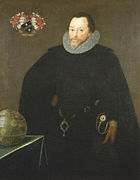
People from Plymouth are known as Plymothians or less formally as Janners. Antarctic explorers Robert Falcon Scott and Frank Bickerton both lived in the city. The artist Beryl Cook lived in Plymouth for much of her life and her paintings depict some of the colourful characters she encountered in the city. Another artist, Robert Lenkiewicz, lived in the city from the 1960s until his death in 2002. The actress Dawn French was educated here at an independent school for girls.
People born in Plymouth include Olympic swimmer Sharon Davies, gold medal-winning diver Thomas Daley, dancer Wayne Sleep, newsreader and journalist Angela Rippon. Other notable residents include footballer Trevor Francis, the tennis player and quiz hostess Sue Barker, and TV presenter Fern Britton.
Landmarks
Plymouth's main geographical landmarks is the Plymouth Sound, which has shaped the city and given it its naval importance. The earliest man-made landmark is the Royal Citadel, built in 1666, to defend the town from naval attacks and to train the armed forces. Further west is Smeaton's Tower, built in 1759, it was a lighthouse out at sea, but was dismantled and rebuilt on Plymouth Hoe in 1877. Today it attracts tourists for its views over Plymouth Sound and the rest of the city, because it is climbable. Opposite the River Plym is the Saltram House estate, which has a Georgian mansion. The Plymouth Hoe has three memorials: A statue of Sir Francis Drake, past mayor of Plymouth; A tall memorial to the lives lost at sea with their names written on plaques; and a memorial to the Royal Air Force. The old village of Plymouth, sutton, is now called the Barbican and still has many of the buildings in tact with cobbled roads, which attract visitors. It is also where the Pilgrim Fathers left for the New World in 1620 at the Mayflower Steps.
